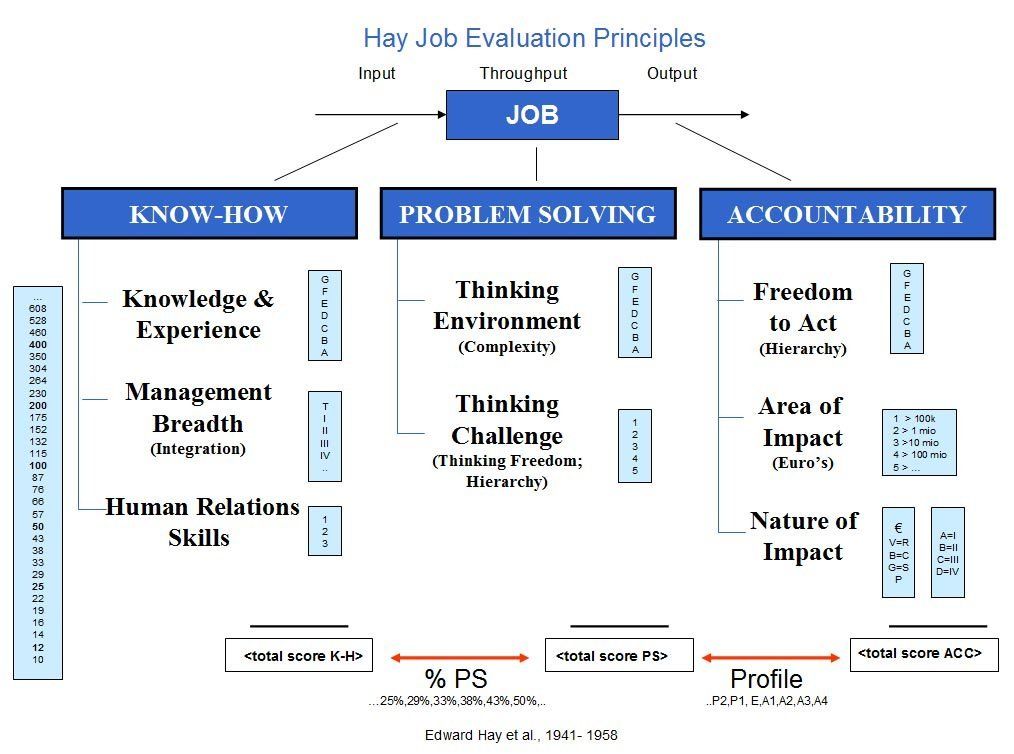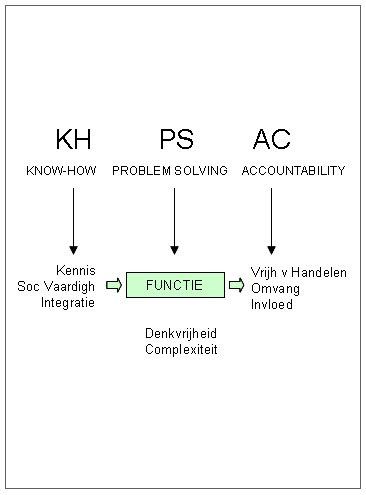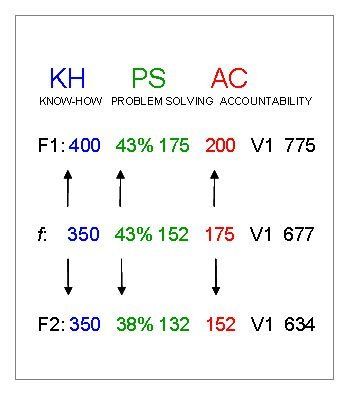HOW DOES THE HAY METHOD WORK?
APPLYING THE HAY METHOD
The Hay method is an elegant way to quickly and accurately value your functions. The method lends itself to first carrying out a 1st-order valuation. Often the level has already been determined. A more detailed valuation can then be set up if desired. Below we explain how this works in principle.
There are several ways to evaluate a function with the Hay method:
1. work from the short Hay profile, and then rate the sub-characteristics if necessary.
2. Compare each sub-feature with those of other functions (and therefore determine step sizes), and then check the result with the Hay profile.
3. rate each sub-characteristic using the Guide Charts (and therefore determine points), and then check the outcome with the Hay profile.
But there is always a question of "evaluating multiple functions simultaneously", ie: either a function relative to comparable functions in a database of already evaluated reference functions, or a number of functions in relation to each other within an organization so that ultimately their appreciation becomes "stuck like the rungs of a ladder."
In the following, it is important to know how the Main Characteristics of the Hay Method and its sub-characteristics are related:
Know-how (KH) is built up from Professional Knowledge, Administrative and/or Conceptual Integration, Social Skills;
Problem Solving (PS) consists of Freedom of Thought and Complexity; and
Accountability (AC) consists of Freedom of Action, Size (€, $) and Influence.
1. The first way works as follows:
Suppose 2 functions F1 and F2 respectively have been found that are somewhat comparable to the function f to be evaluated (see the picture opposite). And their evaluations are:
KH PS AC Pr total
F1: 400 - 43% 175 - 200 - V1 = 775
F2: 350 - 38% 132 - 152 - V1 = 634
Remember, we don't really need to know what "350" actually means. It could - in E. Hay's original views - be any number. What is important is that function F1 apparently has a clear difference in KH compared to F2, so 15% more points and that is (rounded) 400 points.
Apparently PS of function F1 is also clearly heavier than for F2, so there is a difference of 15% (38 --> 43). But if we do not know why 38% was chosen, we can continue - we accept the evaluations of F1 and F2 as they are.
Finally, we see that AC of F1 is two steps (of 15%) heavier than F2: 152 (--> intermediate value175 ) --> 200. As a result, both functions have the same Short Profile, V1: AC is one step heavier than PS.
Now we are going to reflect the function f to be weighted to F1 and F2.
First we determine whether the character of the function is also a V1 profile, or perhaps E or V2. The Database will certainly have appealing examples, for example:
E: Advisor, Researcher (little accountable for results; obligation to make efforts)
V1: Secretary, Product Manager
V2: Project leader, Product development group manager
V3: Sales & Marketing Manager
V4: Production manager (highly accountable for results; result obligation)
Suppose we argue that the character of the function comes closest to V1.
The second factor we now determine is the % Problem Solving. For hierarchical positions this follows from the hierarchy because each higher hierarchical layer has at least 1 step higher Problem Handling. For non-hierarchical positions, this is determined by the nature and freedoms in the work process. Suppose this is very similar to that of F2, so 43%, then 2 of the 3 factors that we need to calculate the total score have already been determined.
The final step is to determine either KH or AC. So for example, whether the 'full basket of knowledge', i.e. subject knowledge, breadth/composite knowledge, and social skills (informing, explaining or persuading) is equal to that of F1 or to that of F2. Suppose we are convinced that F1 -350 points is the best choice, then we have the end result:
f: 350 - 43% 152 - 175 - V1 = 677
This total score can then be translated into a scale classification and a salary.
The special thing about this method is that, apart from the Main Characteristics, none of the underlying sub-characteristics have been discussed or even valued. Only the three main characteristics have been determined by comparing them with known functions, so that the weight of the function is determined.
This was the method that Edward Hay had in mind in the middle of the last century.
If we can work in this way, large numbers of functions can be classified quickly. It is usually possible to quickly determine the Short Profile and the % PS, but then either KH or AC must be determined in more detail. That brings us to the second approach.
Suppose 2 functions F1 and F2 respectively have been found that are somewhat comparable to the function f to be evaluated (see the picture opposite). And their evaluations are:
KH PS AC Pr total
F1: 400 - 43% 175 - 200 - V1 = 775
F2: 350 - 38% 132 - 152 - V1 = 634
Remember, we don't really need to know what "350" actually means. It could - in E. Hay's original views - be any number. What is important is that function F1 apparently has a clear difference in KH compared to F2, so 15% more points and that is (rounded) 400 points.
Apparently PS of function F1 is also clearly heavier than for F2, so there is a difference of 15% (38 --> 43). But if we do not know why 38% was chosen, we can continue - we accept the evaluations of F1 and F2 as they are.
Finally, we see that AC of F1 is two steps (of 15%) heavier than F2: 152 (--> intermediate value175 ) --> 200. As a result, both functions have the same Short Profile, V1: AC is one step heavier than PS.
Now we are going to reflect the function f to be weighted to F1 and F2.
First we determine whether the character of the function is also a V1 profile, or perhaps E or V2. The Database will certainly have appealing examples, for example:
E: Advisor, Researcher (little accountable for results; obligation to make efforts)
V1: Secretary, Product Manager
V2: Project leader, Product development group manager
V3: Sales & Marketing Manager
V4: Production manager (highly accountable for results; result obligation)
Suppose we argue that the character of the function comes closest to V1.
The second factor we now determine is the % Problem Solving. For hierarchical positions this follows from the hierarchy because each higher hierarchical layer has at least 1 step higher Problem Handling. For non-hierarchical positions, this is determined by the nature and freedoms in the work process. Suppose this is very similar to that of F2, so 43%, then 2 of the 3 factors that we need to calculate the total score have already been determined.
The final step is to determine either KH or AC. So for example, whether the 'full basket of knowledge', i.e. subject knowledge, breadth/composite knowledge, and social skills (informing, explaining or persuading) is equal to that of F1 or to that of F2. Suppose we are convinced that F1 -350 points is the best choice, then we have the end result:
f: 350 - 43% 152 - 175 - V1 = 677
This total score can then be translated into a scale classification and a salary.
The special thing about this method is that, apart from the Main Characteristics, none of the underlying sub-characteristics have been discussed or even valued. Only the three main characteristics have been determined by comparing them with known functions, so that the weight of the function is determined.
This was the method that Edward Hay had in mind in the middle of the last century.
If we can work in this way, large numbers of functions can be classified quickly. It is usually possible to quickly determine the Short Profile and the % PS, but then either KH or AC must be determined in more detail. That brings us to the second approach.
Short Profile (V1)
Problem treatment (%)
Knowledge & Skills
Problem treatment (%)
Knowledge & Skills
2. In the second way
two of the Main Factors are determined according to the above approach because they become obvious quite quickly. The third factor is determined by comparing the sub-characteristics, although we still do not bring any points into play. How does that work?
Suppose we knew the following evaluation from the above example:
KH PS AC Pr total
F1: FII3 400 - 43% 175 - 200 - V1 = 775
F2: FII-3 350 - 38% 132 - 152 - V1 = 634
All considerations are now exactly as above, except we now know that both functions apparently have the same level of knowledge (sub-characteristic F), and also the same social skills (sub-characteristic 3). But there is apparently a difference in Administrative and/or Conceptual Integration. Even without knowing exactly what II and II- mean, we can now compare our function to this and try to reason whether our function can be compared with one or the other.
In this way, the function is again scaled based on the Main Characteristics, using a comparison of some relevant sub-factors, without using point maps at all. You only have to reason whether the function is higher, equal or lower in terms of the characteristics, which determines the end result.
Suppose we knew the following evaluation from the above example:
KH PS AC Pr total
F1: FII3 400 - 43% 175 - 200 - V1 = 775
F2: FII-3 350 - 38% 132 - 152 - V1 = 634
All considerations are now exactly as above, except we now know that both functions apparently have the same level of knowledge (sub-characteristic F), and also the same social skills (sub-characteristic 3). But there is apparently a difference in Administrative and/or Conceptual Integration. Even without knowing exactly what II and II- mean, we can now compare our function to this and try to reason whether our function can be compared with one or the other.
In this way, the function is again scaled based on the Main Characteristics, using a comparison of some relevant sub-factors, without using point maps at all. You only have to reason whether the function is higher, equal or lower in terms of the characteristics, which determines the end result.
M. Quaid, "Job Evaluation: The Myth of Equitable Assessment", University of Toronto Press, 1993, pp. 106 - 111
3. In the third way, all sub-characteristics are determined. The combination of the sub-factors then leads to a number for each of the Main Characteristics. We can read this from the Guide Charts. To this end, we use the research of Maeve Quaid at the University of Toronto (1993), who investigated the usefulness and necessity of job evaluation and explained the Hay system in detail. Here are the Hay Guide Charts in public literature.
E. Hay continued to search for valuing jobs according to the first two ways: he wanted to stay away from point systems and as such he did not know of any Guide Charts containing point series: the fields were empty because job titles were noted there in their mutual ranking, but then in step difference. He emphasized the relative differences between functions, and by doing this on just the three Key Characteristics, it became clear that in many situations it was not necessary to descend to fine-scale point systems at all.








